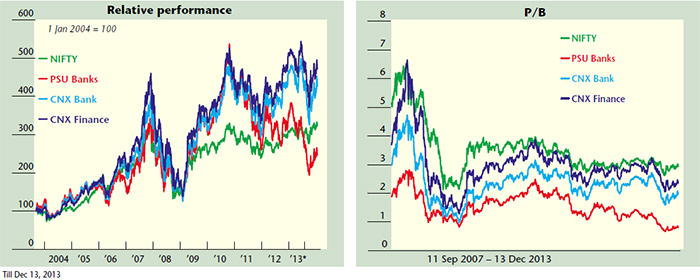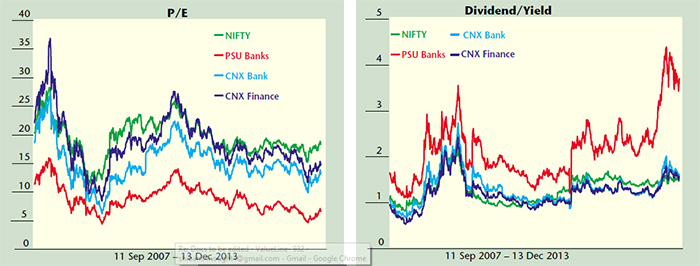
Correction in the valuations of PSU banks offers good entry opportunity for investors
Banking is considered the most important sector in the economy and plays a significant role in the growth and development of any country. The Indian banking sector comprises private banks, public sector(PSU) banks, and foreign banks.
The banking and financial services sector constitutes over 25 per cent weightage in CNX NIFTY, which is a well-diversified, 50-stock, frontline index reflecting overall market conditions. Considering the importance of the banking and financial services sector in the economy, the NSE has designed various sectorial indices, such as CNX Finance, CNX Bank Index and CNX PSU Bank Index, as a benchmark to track the performance of various fund portfolios, index funds, ETFs, and structured products. CNX Finance is a 15-stock index designed to reflect the behaviour and performance of the Indian financial market, which comprises banks, financial institutions, housing finance and other financial services companies. The top 10 constituents of this index have weightages of over 95 per cent, primarily dominated by private sector banking, NBFCs, and housing finance companies, which constitute over 85 per cent weight in the index.
Similarly, CNX Bank, a 12-stock index, comprises most liquid and large capitalised Indian banking stocks. The top 10 constituents of this index have weightages of over 98 per cent, primarily dominated by private sector banks, which constitute over 81 per cent weight in the index.
The CNX PSU Bank Index is a 12-stock index designed to capture performance of public sector (PSU) banks. For the purpose of our analysis, the CNX Finance and CNX Bank Index have been considered a proxy to Indian private banking and financial services space.
India is currently facing its worst slowdown in a decade, with GDP growth falling below the 5 per cent mark. The slow down has resulted in a rise in non-performing assets (NPAs) in the economy. Much of the stress is visible in public sector banks, where gross NPAs have shot up to near 4 per cent for nationalised banks and about 5.5 per cent for SBI and its associates in the June 2013 quarter. Public sector banks are plagued with the problem of rising bad loans, increase in restructured loans, increase in provisions and falling profitability, despite slight improvement in NIMs. Capital adequacy ratios of PSU banks are at abysmally low levels, thereby requiring fresh capital infusion. All this suggests an increase in stress in the economy.
As per the data published by the Reserve Bank of India in A profile of banks: 2012-13, net NPAs of PSU banks have shot up from 0.94 per cent in 2008-09 to 2.09 per cent in 2012-13, as against a sharp improvement in the asset quality of private sector banks and foreign banks during the same period. Lower profitability has affected the overall return on equity and return on assets of PSU banks.
The Reserve Bank of India (RBI) and Finance Minister P. Chidambaram have voiced their concerns over increase in NPAs of public sector banks. They have even asked banks to take measures to recover bad loans. Recently, the RBI has outlined a corrective action plan to tackle the problem of rising NPAs of PSU banks.
Deteriorating fundamentals of PSU banks over the past few years have resulted in a sharp fall in market price and severe contraction in valuation multiples as compared to their private counterparts. The CNX PSU Bank Index has underperformed the CNX Bank Index and CNX Finance Index by a big margin, and is now quoting near six year low valuation multiples.
The CNX PSU Bank Index currently offers a dividend yield of 3.8 per cent and is quoting at 0.8 times price to book value and 6.7 times price to earnings, reflecting ongoing stress in the PSU banking space.
India’s economy is currently going through the painful process of bottoming out, and any uptick in it will result in an improvement in asset quality for these banks. The interest rate cycle is also close to its peak and any softening of interest rates will result in treasury gains for these banks.
The significant divergence in valuations of PSU banks and private sector banks provide an attractive investment opportunity for the patient investor. As economic recovery pick up its pace, this valuation gap will eventually narrow down. This is the time to pick good quality PSU banks to reap the benefits when the economic cycle turns up ward.
This article was originally published in Business India Magazine.
Write to us at news@valuelineadvisors.com
Disclaimer: The views expressed in this article are personal and the author is not responsible in any manner for the use which might be made of the above information. None of the contents make any recommendation to buy, sell or hold any security and should not be construed as offering investment advice.

